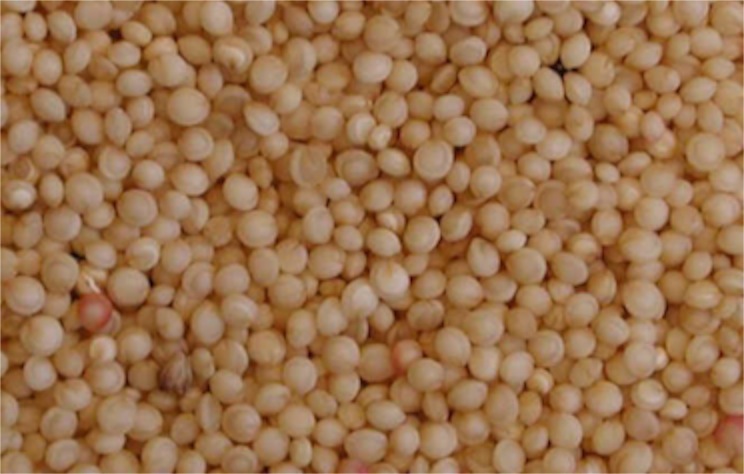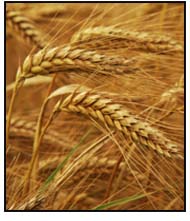Biblical Grains
05/01/12 05:20
On the eleventh day of Christmas, my true love gave to me . . . quick do you remember the verse . . . OK, it’s Lords a leaping. Tomorrow is epiphany and a day of changing seasons for Christians. It is time to put away the Christmas decorations and focus our attention on the gift of the light of God. The tradition of January 6 celebrations comes from the symbolic date attached to the visit of the magi, or kings, to the infant Jesus. Christians assert that the visit was the first acknowledgment of Jesus by people outside of the Jewish community. The gift of the messiah was to the entire world and not just to a circle of believers. There are a lot of different ways to celebrate the occasion.

This year, because Epiphany falls on a Friday, liturgical congregations have to make a bit of a choice. When Epiphany falls at the end of the week, the Sunday closest to the day, traditionally the time to celebrate epiphany is the same day as Baptism of Christ Sunday. Congregations can elect to recognize Epiphany Sunday, with its set of readings or Baptism of Christ Sunday, with another set of readings, or combine the two occasions and either read both sets of readings, or read some readings from each set. If all of this is a bit confusing, join the club. I’ve been a pastor serving local congregations for 33 years and I still am confused.
But all of that is about tomorrow or Sunday. Today is the eleventh day of Christmas and all of that business of leaping lords makes no more sense. What does seem to happen about this time of the year is that I get tired of reading the incessant “top ten,” “best and worst,” “in and out” lists that newspapers, magazines, and web sites love to publish at this time of the year. What made me swear off the lists for another year was the Washington Post’s list of what is in and what is out. Most of the items I simply ignore, because they have to do with fashion, politics and popular culture all of which change week to week so any sense of a year’s predictions seems to be silly at best. And, since I don’t watch much television, I never know the popular shows or the actors.
This year, however, the Washington Post list included that Quinoa is “out” and Amaranth is “in,” stating that there seems to be room for only one “biblical” grain at a time. Somebody didn’t do his or her homework. Neither Quinoa nor Amaranth is a grain. And neither could be classified as biblical.
If you sense one of my “rants” coming on, you might be right. This could be another essay about an obscure subject that no one else cares about. So I’ll try to keep it simple.
Quinoa and Amaranth are both grain-like crops that come from South America. They might be similar enough to substitute in some recipes, but they are really quite different from each other and from traditional grains. The grains we consume today are quite different from the varieties that were grown in the Middle East in Biblical times. Simple, non hybrid varieties of barley, millet and rye were probably the only grains known in Biblical times, along with a wheat variety that is known as Khorasan wheat and sold under the brand name Kamut.

Quinoa
Grains are grasses that are harvested for their seeds. The seeds are ground and usually made into breads or pastas. There are a lot of different varieties of grain. Politicians have debated whether corn is a grain or a vegetable, but botanists come down on the side of grain. OK technically it is a dried fruit, but that argument would be so obscure that even botanists get bored with it.
I reacted to the Washington Post article, because of the flippant use of the word “biblical” rather than the technical botanical definition of grain. Quinoa is a crop grown for its edible seeds. It is not a member of the grass family like barley or wheat, but rather a chenopod, more closely related to beets, spinach and tumbleweeds than to grains. It comes from Central and South America. The Incas held the crop to be sacred and referred to it as the “mother of all grains.” It is NOT mentioned in the Bible, nor would it have been known to any of the persons in the Bible.

Amaranth
Amaranth has a name that at least sounds a bit more Biblical, but it is not so. It is found across Asia and the Americas, but not in Europe or the Middle East. It is a leafy plant and probably fits into the category of herbs. The seeds are dried and ground, and like Quinoa, can be substituted for grain in some recipes. Neither contains gluten, so are options for people with Coeliac disease. Both are relatively exotic, less available, and more expensive than other gluten-free options such as buckwheat, corn, millet, wild rice and oats.
Khorasan wheat, or Kamut, however, may actually be a Biblical grain. Although it is not specifically mentioned in the Bible, it does date to the time and the region of the Bible. Here is the story of that grain: In 1949, a US Airman received 32 grains of the wheat from Egypt. He sent those grains to his father’s farm near Fort Benton, Montana. For the next fifteen years or so, his father maintained a small, but growing plot of the grain and called it “King Tut’s Wheat.” It showed little commercial promise. Bags of the seed were sold as a curiosity at the Choteau County Fair, and perhaps for a few years at the Montana State Fair in Great Falls. A few farmers cultivated small plots. It was a locally known variety and had no commercial value, however, until it was “rediscovered” in the 1980’s and the trademark “Kamut” was registered for the grain in 1990. Kamut does have gluten, but it seems to be more easily digested and some people with Coeliac disease can tolerate limited quantities of the grain. It makes flour that can easily be substituted without otherwise altering recipes.

Kamut
I only know this stuff because members of my family have been raising grain near Fort Benton, Montana for six generations. They don’t grow Quinoa or Amaranth. They do grow Kamut. And they do have a cousin who is a stickler for the misuse of the word “biblical.”
That same cousin knows nothing about leaping lords.

This year, because Epiphany falls on a Friday, liturgical congregations have to make a bit of a choice. When Epiphany falls at the end of the week, the Sunday closest to the day, traditionally the time to celebrate epiphany is the same day as Baptism of Christ Sunday. Congregations can elect to recognize Epiphany Sunday, with its set of readings or Baptism of Christ Sunday, with another set of readings, or combine the two occasions and either read both sets of readings, or read some readings from each set. If all of this is a bit confusing, join the club. I’ve been a pastor serving local congregations for 33 years and I still am confused.
But all of that is about tomorrow or Sunday. Today is the eleventh day of Christmas and all of that business of leaping lords makes no more sense. What does seem to happen about this time of the year is that I get tired of reading the incessant “top ten,” “best and worst,” “in and out” lists that newspapers, magazines, and web sites love to publish at this time of the year. What made me swear off the lists for another year was the Washington Post’s list of what is in and what is out. Most of the items I simply ignore, because they have to do with fashion, politics and popular culture all of which change week to week so any sense of a year’s predictions seems to be silly at best. And, since I don’t watch much television, I never know the popular shows or the actors.
This year, however, the Washington Post list included that Quinoa is “out” and Amaranth is “in,” stating that there seems to be room for only one “biblical” grain at a time. Somebody didn’t do his or her homework. Neither Quinoa nor Amaranth is a grain. And neither could be classified as biblical.
If you sense one of my “rants” coming on, you might be right. This could be another essay about an obscure subject that no one else cares about. So I’ll try to keep it simple.
Quinoa and Amaranth are both grain-like crops that come from South America. They might be similar enough to substitute in some recipes, but they are really quite different from each other and from traditional grains. The grains we consume today are quite different from the varieties that were grown in the Middle East in Biblical times. Simple, non hybrid varieties of barley, millet and rye were probably the only grains known in Biblical times, along with a wheat variety that is known as Khorasan wheat and sold under the brand name Kamut.

Quinoa
Grains are grasses that are harvested for their seeds. The seeds are ground and usually made into breads or pastas. There are a lot of different varieties of grain. Politicians have debated whether corn is a grain or a vegetable, but botanists come down on the side of grain. OK technically it is a dried fruit, but that argument would be so obscure that even botanists get bored with it.
I reacted to the Washington Post article, because of the flippant use of the word “biblical” rather than the technical botanical definition of grain. Quinoa is a crop grown for its edible seeds. It is not a member of the grass family like barley or wheat, but rather a chenopod, more closely related to beets, spinach and tumbleweeds than to grains. It comes from Central and South America. The Incas held the crop to be sacred and referred to it as the “mother of all grains.” It is NOT mentioned in the Bible, nor would it have been known to any of the persons in the Bible.

Amaranth
Amaranth has a name that at least sounds a bit more Biblical, but it is not so. It is found across Asia and the Americas, but not in Europe or the Middle East. It is a leafy plant and probably fits into the category of herbs. The seeds are dried and ground, and like Quinoa, can be substituted for grain in some recipes. Neither contains gluten, so are options for people with Coeliac disease. Both are relatively exotic, less available, and more expensive than other gluten-free options such as buckwheat, corn, millet, wild rice and oats.
Khorasan wheat, or Kamut, however, may actually be a Biblical grain. Although it is not specifically mentioned in the Bible, it does date to the time and the region of the Bible. Here is the story of that grain: In 1949, a US Airman received 32 grains of the wheat from Egypt. He sent those grains to his father’s farm near Fort Benton, Montana. For the next fifteen years or so, his father maintained a small, but growing plot of the grain and called it “King Tut’s Wheat.” It showed little commercial promise. Bags of the seed were sold as a curiosity at the Choteau County Fair, and perhaps for a few years at the Montana State Fair in Great Falls. A few farmers cultivated small plots. It was a locally known variety and had no commercial value, however, until it was “rediscovered” in the 1980’s and the trademark “Kamut” was registered for the grain in 1990. Kamut does have gluten, but it seems to be more easily digested and some people with Coeliac disease can tolerate limited quantities of the grain. It makes flour that can easily be substituted without otherwise altering recipes.

Kamut
I only know this stuff because members of my family have been raising grain near Fort Benton, Montana for six generations. They don’t grow Quinoa or Amaranth. They do grow Kamut. And they do have a cousin who is a stickler for the misuse of the word “biblical.”
That same cousin knows nothing about leaping lords.